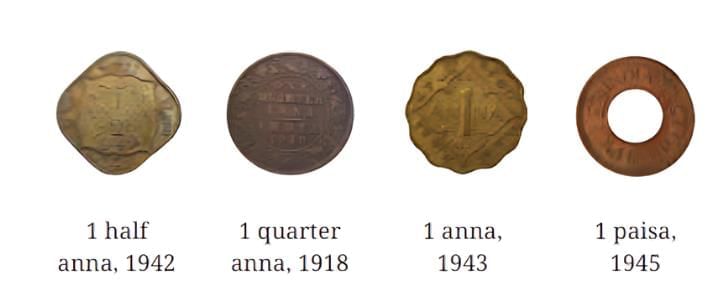From Barter to Money Class 7 Notes Social Science Chapter 11 Free PDF
| Table of contents |

|
| Introduction |

|
| Why Do We Need Money? |

|
| Basic Functions of Money |

|
| The Journey of Money |

|
| Points to Remember |

|
| Difficult Words |

|
Introduction
- Cowrie shells
- Salt
- Cloth
- Cattle
However, this system was inefficient.
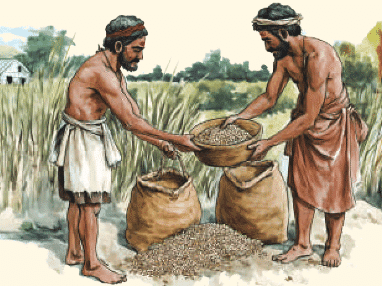 Barter System
Barter System
- Money evolved as a common tool that everyone accepts for buying or selling goods and services, making trade much easier.
- Today, we use coins, notes, and digital methods (like mobile payments) to conduct transactions.
- John Maynard Keynes, a renowned economist, stated that money connects the present to the future by helping us save and spend later.
Why Do We Need Money?
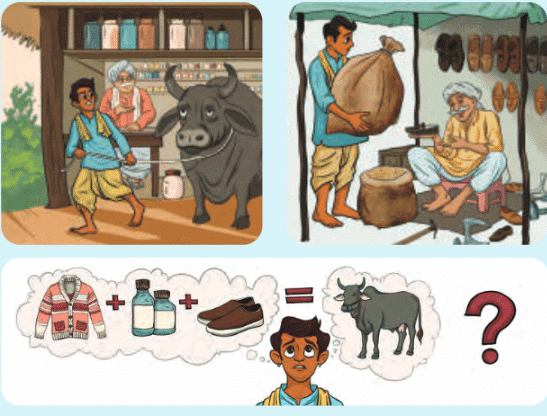
- Double coincidence of wants: The farmer must find someone who wants an ox and offers exactly what he needs (shoes, sweater, medicines). This is rare.
- Common standard measure of value: It’s hard to decide how much an ox is worth compared to shoes or medicines, as there’s no agreed value.
- Divisibility: An ox cannot be split into parts for smaller trades, like for a sweater.
- Portability: Carrying an ox or bags of wheat (traded for the ox) to different places is difficult.
- Durability: Wheat rots or gets eaten by rats, so it cannot be stored for long.
These problems made trading slow and complex, so a better system was needed. Money solves these issues by being a common, portable, divisible, and durable way to trade.
- Junbeel Mela in Assam, where people trade roots, vegetables, and handmade goods for rice cakes and food.
- Book exchanges, where people swap old books for new ones.
- Trading old clothes for new utensils, benefiting both households and vendors.
Basic Functions of Money
Money was invented to make trading easier as the barter system became complex with more goods and longer distances. Money simplifies trade, supports salaries, school fees, and everyday purchases, making life easier than barter.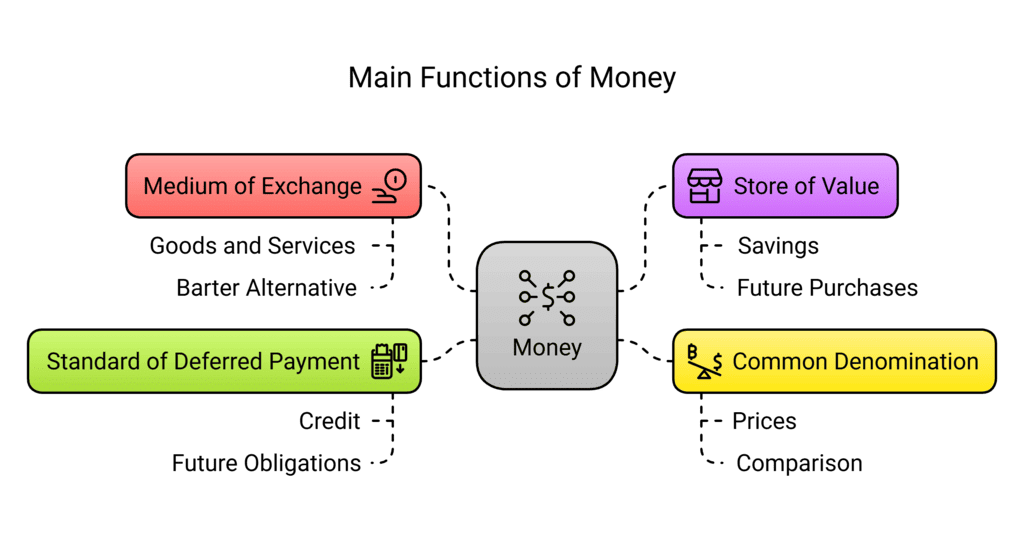
- Medium of exchange: Money is used to buy and sell goods and services, accepted by everyone, unlike barter’s need for double coincidence.
- Store of value: Money can be saved and used later, unlike wheat that rots. For example, a farmer can keep money from selling an ox for future purchases.
- Common denomination: Money measures the value of goods (prices), making it easy to compare items, like books or shoes.
- Standard of deferred payment: Money allows payments to be made later. For example, if a book costs ₹100 but you have ₹50, you can ask the shopkeeper to accept the rest later.
The Journey of Money
Money has changed over time to meet people’s needs.
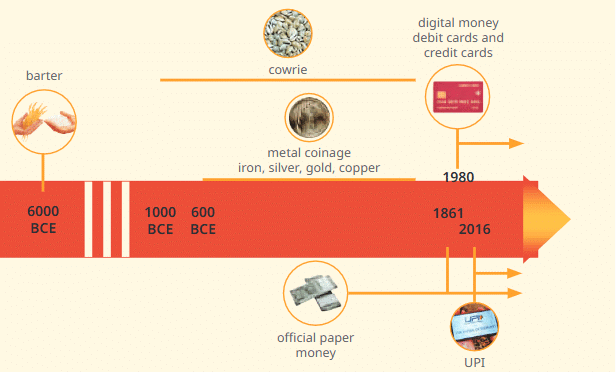 Journey of Money
Journey of Money
- Items like cowrie shells, Rai stones (giant rock discs in Micronesia), Aztec copper Tajadero, and red feather coils (Solomon Islands) were used as money.
- Coins were among the earliest forms of money, issued by rulers for use in their kingdoms. Different kingdoms had their own coinage, and the minting of coins was fully controlled by the rulers.
- Over time, the coins of powerful rulers were accepted in other kingdoms too, which made trade easier across regions.
- Coins were usually made of precious metals like gold, silver, copper, or their alloys. They were called kārṣhāpaṇas or paṇas and had symbols on them known as rūpas.
- In ancient times, coins had two sides – the head (obverse) and the tail (reverse). Each side showed different designs such as animals, trees, hills, kings, queens, or gods.
- For example, the Chalukya coins had Varaha (an avatar of Vishnu) engraved on one side and a decorated three-tiered parasol on the other.
- The use of coins gave a major boost to India’s maritime trade, and coins have been found in Kerala and Tamil Nadu, proving that southern India had active trade with the world.
- Scholars believe this trade was largely favourable to India.
 Roman Gold coins
Roman Gold coins
Earlier, 1 anna, which was 1/16 of a rupee, was enough to buy a dozen bananas in 1947. Today, coins come in different sizes and denominations, show both Hindi and English, and special coins are minted to mark important national events.
Ancient coins were made from silver and copper alloys, while today’s coins are mostly made of iron mixed with small amounts of chromium, silicon, and carbon in exact proportions.
- Paper money began in China and was introduced in India in the late 18th century by banks like the Bank of Bengal and Bank of Bombay.
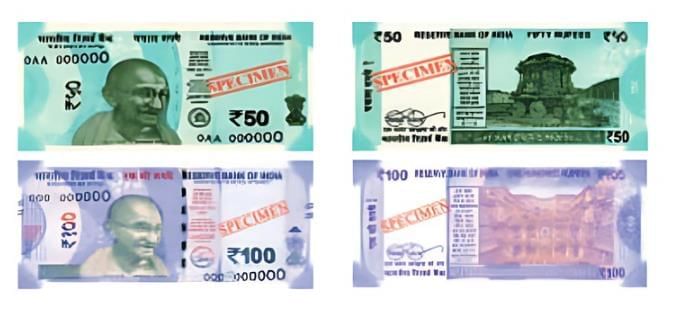 Paper Currency
Paper Currency - Used for higher denominations (e.g., ₹10, ₹100, ₹500), while coins are for smaller ones (e.g., ₹1, ₹5).
- Modern notes have cultural motifs (e.g., on ₹50 or ₹100 notes) and special features like raised marks for the visually impaired to identify denominations.
- The Reserve Bank of India (RBI) is the only legal authority to issue currency in India, ensuring control and preventing illegal printing.
The ₹ symbol was adopted in 2010, designed by Udaya Kumar of IIT Bombay, and it combines the Devanagari “Ra” and the Roman “R” with two parallel stripes that represent the national flag and the “equal to” sign.
- With the advancement of technology, money started taking an intangible form that cannot be touched, known as digital money.
- For example, Krishnappa, who sells seasonal fruits on a cart, uses a QR code for payments, allowing customers to scan it with their phones and pay digitally, with the money going directly into his bank account.
- Other methods include debit cards, credit cards, net banking, and UPI (Unified Payments Interface), moving money directly between bank accounts.
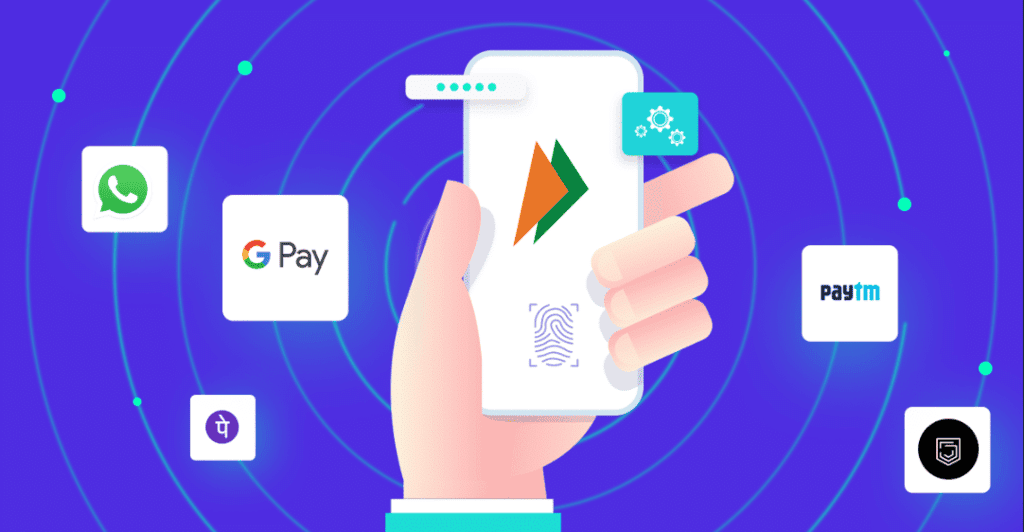 UPI
UPI
Points to Remember
- Barter → First trade system, but had limitations like the double coincidence of wants and lack of durability.
- Money introduced → Solved problems of barter.
- Coins and paper notes → Became official currency.
- RBI issues currency in India.
- Today, digital money is widespread, making transactions faster and easier.
- Money evolved from coins and paper currency to digital forms like UPI and QR codes.
Difficult Words
- Barter System: Exchanging goods or services without using money.
- Money: A common tool accepted for buying or selling goods and services.
- Transaction: A business deal, like buying or selling something.
- Commodities: Items used for trade, like cowrie shells or cattle.
- Double coincidence of wants: When two people each have what the other wants for trade.
- Common standard measure of value: An agreed way to measure the worth of goods.
- Divisibility: The ability to split something into smaller parts for trade.
- Portability: The ease of carrying or moving something.
- Durability: The ability of something to last long without damage.
- Medium of exchange: Something accepted by all for buying and selling.
- Store of value: Something that can be saved and used later.
- Common denomination: A way to measure and compare the value of goods.
- Standard of deferred payment: Using money to pay for something later.
- Coinage: Coins used as money, often made by rulers.
- Currency: The money system of a country, like rupees in India.
- Minting: The process of making coins. A mint is a factory where coins are produced to be used as a country’s currency.
- Alloy: A metal created by combining two or more metals, which makes coins stronger.
- Denominations: Different units of money, like ₹1 or ₹100.
- Obverse: The front side of a coin with the main design.
- Digital money: Money in electronic form, not physical coins or notes.
- QR Code: A pattern of squares scanned by phones for digital payments.
FAQs on From Barter to Money Class 7 Notes Social Science Chapter 11 Free PDF
| 1. What are the basic functions of money? |  |
| 2. Why did societies move from barter to money? |  |
| 3. What is the journey of money throughout history? |  |
| 4. How does money serve as a store of value? |  |
| 5. What are some difficult words related to money? |  |

